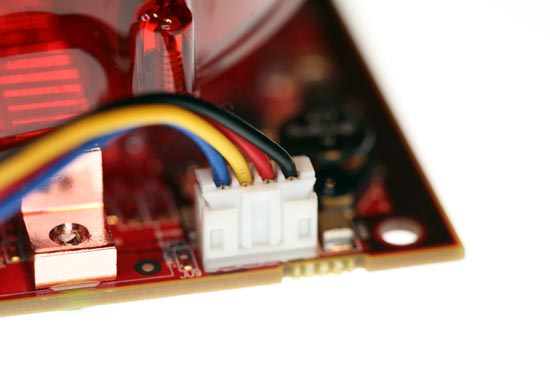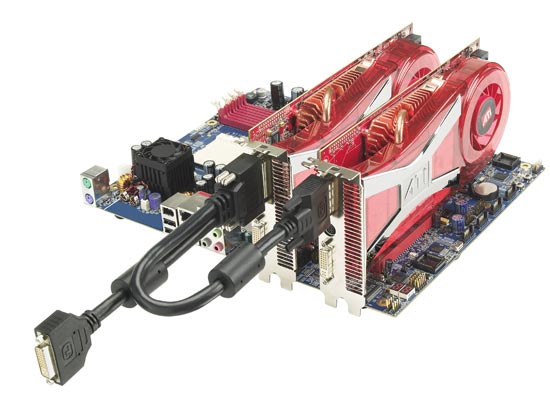ATI's New High End and Mid Range: Radeon X1950 XTX & X1900 XT 256MB
by Derek Wilson on August 23, 2006 9:52 AM EST- Posted in
- GPUs
A Faster, Cheaper High-End
While the X1900 XTX made its debut at over $600USD, this new product launch sees a card with a bigger, better HSF and faster memory debuting at a much lower "top end" price of $450. Quite a few factors play into this, not the least of which is the relatively small performance improvement over the X1900 XTX. We never recommended the X1900 XTX over the X1900 XT due to the small performance gain, but those small differences add up and with ATI turning their back on the X1900 XTX for its replacement. We can finally say that there is a tangible difference between the top two cards offered by ATI.

This refresh part isn't as different as other refresh parts, but the price and performance are about right for what we are seeing. Until ATI brings out a new GPU, it will be hard for them to offer any volume of chips that run faster than the X1950 XTX. The R5xx series is a very large 384 million transistor slice of silicon that draws power like its going out of style, but there's nothing wrong with using the brute force method every once in a while. The features ATI packed in the hardware are excellent, and now that the HSF is much less intrusive (and the price is right) we can really enjoy the card.
Speaking of the thermal solution, it is worth noting that ATI has put quite abit of effort into improving the aural impact of its hardware. The X1900 XTX is not only the loudest card around, but it also possesses a shrill and quite annoying sound quality. In contrast, the X1950 XTX is not overly loud even during testing when the fan runs at full speed, and the sound is not as painful to hear. We are also delighted to find that ATI no longer spins the fan at full speed until the drivers load. After the card spins up, it remains quiet until it gets hot. ATI has upgraded their onboard fan header to a 4-pin connection (following in the footsteps of NVIDIA and Intel), allowing them a more fine grained control over their fan speed.

While the X1950 XTX is not as quiet as NVIDIA's 7900 GTX solution, it is absolutely a step in the right direction. That's not to say their aren't some caveats to this high end launch.
Even before the introduction of SLI, every NVIDIA GPU had the necessary components to support multiple GPU configurations in silicon. Adding an "over the top" SLI bridge connector to cards has resulted in the fact that nearly every NVIDIA card sold is capable of operating in multi-GPU mode. While lower end ATI products don't require anything special to work in tandem, the higher end products have needed a special "CrossFire" branded card with an external connector and dongle capable of receiving data from a slave card.
While this isn't necessarily a bad solution to the problem, it is certainly less flexible than NVIDIA's implementation. In the past, in order to run a high end multi-GPU ATI configuration, a lower clocked (compared to the highest speed ATI cards) more expensive card was needed. With the introduction of X1950 CrossFire, we finally have an ATI multi-GPU solution available at the highest available clock speed offered and at the same price as a non-CrossFire card.

While this may not be a problem for us, it might not end up making sense for ATI in the long run. Presumably, they will see higher margins from the non-CrossFire X1950 card, but the consumer will see no benefit from staying away from CrossFire. (Note that the CrossFire cable still offers a second DVI port.) In fact, the benefits of having a CrossFire version are fairly significant in the long run. As we mentioned, 2 CrossFire cards can be used in CrossFire with no problem, each card could be used as a master in other systems offering greater flexibility and a higher potential resale value in the future.
If the average consumer realizes the situation for what it is, we could see some bumps in the road for ATI. It's very likely that we will see lower availability of CrossFire cards, as the past has shown a lower demand for such cards. Now that ATI has taken the last step in making their current incarnation of multi-GPU technology as attractive and efficient as possible, we wouldn't be surprised if demand for CrossFire cards comes to completely eclipse demand for the XTX. If demand does go up for the CrossFire cards, ATI will either have a supply problem or a pricing problem. It will be very interesting to watch the situation and see which it will be.
Before we move on to the individual game tests, lets take a look at how the X1950 XTX stacks up against its predecessor the X1900 XTX. Mouse over the links below the image to look at the performance difference between the X1950 XTX and the X1900 XTX at that resolution.

1280 x 1024 1920 x 1440 2048 x 1536
For our 29% increase in memory clock speed, we are able to gain at most an 8.5% performance increase in SC:CT. This actually isn't bad for just a memory clock speed boost. Battlefield 2 without AA took home the least improvement with a maximum of 2.3% at our highest resolution.
Our DirectX games seem to show a consistently higher performance improvement with AA enabled due to memory speed. This is in contrast to our OpenGL games (Quake 4 and F.E.A.R.) which show a pretty constant percent improvement at each resolution with AA enabled while scaling without AA improves as resolution increases. Oblivion improvement seems to vary between 2% and 5%, but this is likely due to the variance of our benchmark between runs.










74 Comments
View All Comments
nextsmallthing - Wednesday, August 23, 2006 - link
Did anyone else notice that the specs for some of the NVIDIA cards are wrong? For example, the core clock of the 7900GTX is supposed to be 650 MHz, not 700 MHz, and the core clock of the 7900GT should be 450 MHz, not 470 MHz. Also, the pipeline configuration for the 7300GT (according to Wikipedia anyway) should be 8 pixel & 4 vertex.This many mistakes really makes me question the accuracy of other specs I read on Anandtech.
(And by the way, would somebody please inform the DailyTech writers that it's "Xbox 360", not "XBOX 360". And yes I'm aware of the conventions that punctuation goes inside quotes and you shouldn't start sentences with "and".)
Anand Lal Shimpi - Wednesday, August 23, 2006 - link
The 7900GTX/GT clock speeds that were listed were actually vertex clock speeds, not general core clock speeds, so they were technically correct (parts of the GPU do run at those frequencies) just not comparable to the other numbers. They have been corrected.The 7300GT is indeed 8 pipes, that was a copy/paste error. Thanks for the heads up.
Take care,
Anand
nextsmallthing - Thursday, August 24, 2006 - link
Wow--prompt correction and courteous reply. I'm impressed, and my faith in Anandtech is restored!Josh7289 - Wednesday, August 23, 2006 - link
From the looks of the pricing structure for ATI's cards on the first page, and especially from the looks of the pricing structure for ATI's cards after they simplify their lineup, it looks like ATI is giving up on midrange cards, from $100 - $200. The 7600GT and the upcoming 7900GS both are alone in that price range (about $150 and $200, respecitively), with no competition from ATI, so it seems they really are giving that price range to Nvidia.Am I right with this or am I seriously missing something?
yyrkoon - Wednesday, August 23, 2006 - link
there is a x1800GTO2, price last I looked was around $230, of course, they released it rather quietly. Still, thats about $90 higher than the 7600 GT (or in my case the eVGA 7600GT KO).OrSin - Wednesday, August 23, 2006 - link
I wondering the same thing. Are they going to stop making any 1800's. They should be dropping in this price range nicely. Not sure how competative they are with the 7900's. And now that the 7900GS is coming out the 1800 might be just too outclassed. (you guys just missed a great deal on woot 7900GS for $145).I hope 1800 drop is still being made and I hope it drops to $150-180 range to fill that gap.
JarredWalton - Wednesday, August 23, 2006 - link
I think they've already stopped making all of the X1800 series, but there are still cards floating around.Josh7289 - Wednesday, August 23, 2006 - link
The X1900GT is a card meant to compete with the stock 7900GT, and as such is somewhere around the $200 - $250 price range.As for the X1950 Pro and X1650 XT, what are these supposed to compete against and at what prices. More importantly, when are these supposed to launch?
coldpower27 - Wednesday, August 23, 2006 - link
As well the X1650 XT is also in the works.coldpower27 - Wednesday, August 23, 2006 - link
X1950 Pro, is upcoming, as well they still have the X1900 GT.